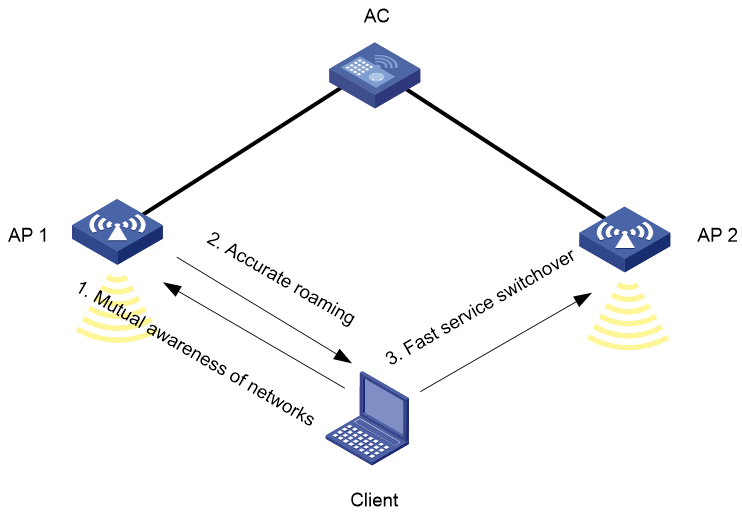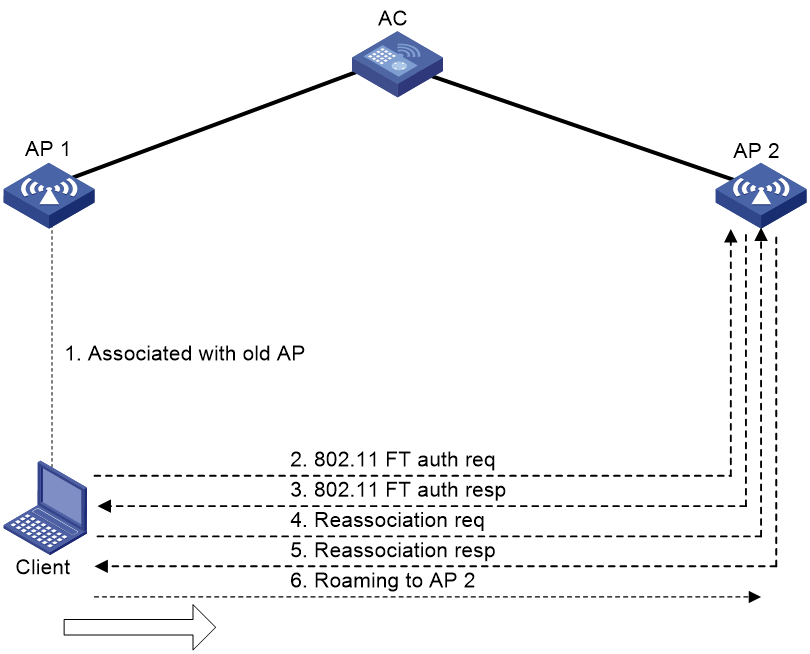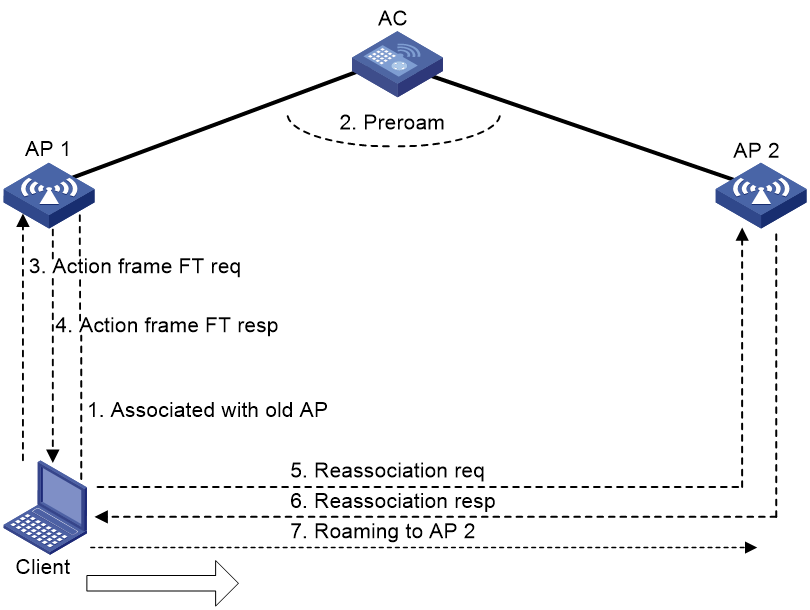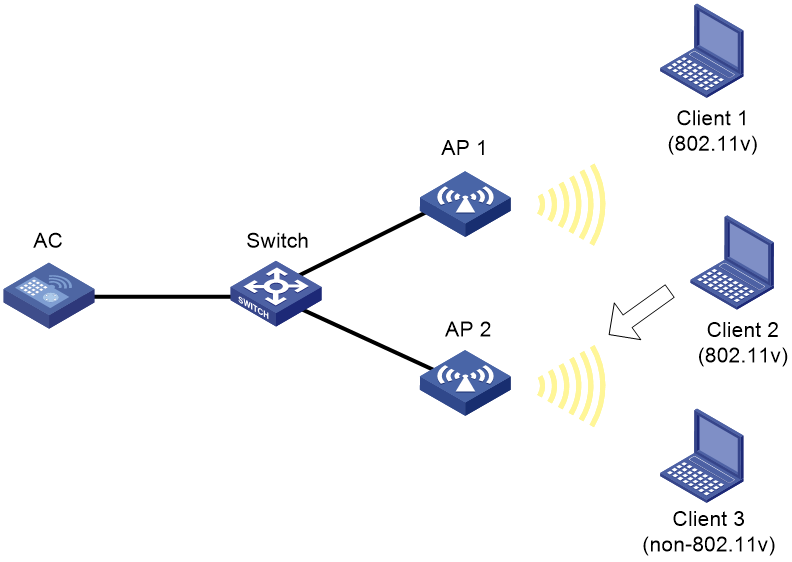- Released At: 31-07-2025
- Page Views:
- Downloads:
- Table of Contents
- Related Documents
-
Cooperative Roaming Technology White Paper
Copyright © 2024 New H3C Technologies Co., Ltd. All rights reserved.
No part of this manual may be reproduced or transmitted in any form or by any means without prior written consent of Hangzhou H3C Technologies Co., Ltd.
Except for the trademarks of New H3C Technologies Co., Ltd., any trademarks that may be mentioned in this document are the property of their respective owners.
The information in this document is subject to change without notice.
Overview
Background
Roaming refers to the process where a wireless client moves from accessing one AP to another within a zone where different APs provide the same Service Set Identifier (SSID). In traditional roaming, clients control their roaming behaviors independently. The access controller (AC) lacks collaborative interaction with clients in roaming detection and decision-making processes, resulting in suboptimal roaming performance.
The main issues with current roaming include:
· Client stickiness: Some client roaming algorithms prioritize persistence with the already connected AP. In this case, a client will not actively switchover to a better AP nearby unless the signal strength of the currently connected AP degrades to nearly unusable levels. The client cannot quickly connect to the nearest AP wherever the user goes.
· Time-consuming roaming: Clients must detect the communication quality, scan the wireless environment, select the appropriate AP, and perform a service switchover to complete a roaming process. Since the client lacks a full network perspective, it cannot quickly scan for available services. It must scan each channel individually and select an available service, resulting in a time-consuming process with severe packet loss.
· Frequent roaming: Clients roam autonomously based on their own roaming policies and also under the guidance of the AC. However, this might cause clients to roam repeatedly between two APs, preventing persistence on an appropriate AP.
To optimize the roaming experience, cooperative roaming combining IEEE 802.11k, 802.11v, and 802.11r protocols has emerged. Cooperative roaming refers to the cooperation among AP, AC, and clients to facilitate roaming. APs and clients mutually sense network conditions. The AC uses data collected from clients by APs for comprehensive calculations and recommends suitable APs to clients at the right time to enhance user experience. See Figure 1.
Benefits
Cooperative roaming offers the following advantages:
· The AC and wireless clients mutually perceive the network topology from their respective perspectives, enabling the wireless clients to quickly discover the optimal wireless service.
· The AC calculates the neighboring APs around the current access service of a client and actively guides the client to roam to the best neighboring AP, reducing client stickiness.
· This reduces the number of key negotiation packets required during roaming to shorten the delay in the roaming process.
· The AC analyzes data from clients that roam repeatedly and stops prompting the client to roam once the client connects to the optimal AP, reducing the occurrence of repeated roaming.
Implementation
Operating mechanism
Mutual awareness network
The method by which an AP and a client detect each other is as follows:
· The AP periodically checks the client RSSI and flexibly adjusts the roaming sensitivity, allowing the AC to guide client roaming at the most appropriate time. When the following conditions are met, the AC actively guides client roaming to reduce client stickiness:
¡ During the detection period, the client average RSSI is much lower than the roaming threshold.
¡ During two adjacent detection periods, the client average RSSI weakens. The average RSSI in the second period is near the cooperative roaming threshold, and the most recently collected RSSI is much lower than the cooperative roaming threshold.
· The AP interacts with the client to perceive network topology, improving the efficiency and quality of roaming.
¡ The AP periodically provides the client with channel and wireless service information of neighbor APs. The client does not need to scan each channel individually. This reduces the time it takes for the client to discover APs.
¡ The AP periodically sends requests to the client to collect BSS information detected on the current working channel. The AC generates a candidate BSS list based on the reported information from the client and uses the list to guide client roaming. This makes the AC roaming decision more in line with the client network quality assessment criteria.
Precise roaming
The AC actively negotiates with clients to help clients switchover to the nearest suitable AP, reducing client stickiness.
· The AC combines the network environment information of APs and each client to perform a comprehensive calculation. This enables the AC to find more suitable client access locations and optimizes the roaming experience of each client.
· The AC accurately predicts the roaming destination AP for clients based on their historical roaming data and real-time statistics of the entire wireless network. The advantages of prediction based on historical roaming trajectories are as follows:
¡ Client roaming does not rely on client response. Although the traditional 802.11k protocol allows clients to measure data from surrounding neighbors, different clients respond differently to measurement requests. Issues such as non-support for measurements, no response, or erroneous neighbor responses make it difficult to obtain accurate neighbor information.
¡ By predicting the roaming destination APs based on the common trajectories of wireless clients within an area in different directions, the recommended neighbors are more accurate and align with client habits.
Fast service switchover
This feature allows key negotiation and installation during the wireless link association phase. This reduces the number of key negotiation packets exchanged during roaming, shortens the roaming delay, and allows clients to complete authentication more quickly when roaming to a new AP. Fast service switchover supports the over-the-air and over-the-DS methods.
Over-the-Air
Clients communicate directly with the destination AP for pre-roaming authentication. This method is suitable for scenarios with high roaming compatibility requirements. When a client roams from AP 1 to AP 2, the information exchange process is as follows:
1. The client comes online from AP 1.
2. The client sends an authentication request to AP 2.
3. The client receives an authentication response from AP 2.
4. The client sends a reassociation request to AP 2.
5. The client receives a reassociation response from AP 2.
6. The client completed roaming from AP 1 to AP 2.
Over-the-DS
Clients communicate with the destination AP through the current AP to perform pre-roaming authentication. This method is suitable for scenarios with high roaming performance requirements. When a client roams from AP 1 to AP 2, the information exchange process is as follows:
1. The client establishes a connection with AP 1.
2. The AC generates, synchronizes, and saves the roaming entry for the client.
3. The client prepares for roaming and sends an FT authentication request to AP 1.
4. The client receives an FT authentication response from AP 1.
5. The client sends a reassociation request to AP 2.
6. The client receives a reassociation response from AP 2.
7. The client completed roaming from AP 1 to AP 2.
Roaming suppression
As shown in Figure 4, after detecting that a client performs roaming repeatedly, the AC retrieves data from the client roaming process and computes the AP most suitable for the client to remain on. When the client roams to that AP again, the AC will not guide the client to roam further to avoid continued repetitive roaming. When a superior access location is available, the AC can continue to guide client roaming.
Dynamic threshold adjustment
For the AC to guide client roaming, you must configure the link quality threshold. Different network environments and clients have varying link qualities, thus the thresholds required also differ. Cooperative roaming provides a full perspective on wireless client roaming behaviors, dynamically adjusting the link quality threshold that triggers client roaming. This achieves dynamic adjustment of roaming thresholds for individual clients on a network, ensuring an optimal wireless client roaming experience.
Application scenarios
Typical applications of cooperative roaming
As shown in Figure 5, most clients in the network support the 802.11k, 802.11v, and 802.11r protocols. Configure cooperative roaming to enable seamless roaming of clients within an Extended Service Set (ESS) area and optimize the roaming experience. The specific configuration for the AC is as follows:
1. Enable BSS switchover management for the wireless service template, so that the AC can notify clients to access a more suitable BSS.
2. Configure BSS disassociation for the wireless service template. When the device receives a BSS switchover query from a client, it will request the client to switch the BSS, guiding the client to perform BSS switchover. (The feature is enabled by default.)
3. Enable radio resource measurement in radio view to inform clients about the channel quality and available resources measured by APs.
4. Configure client anti-sticky in radio view to allow the client to disconnect from the current BSS and connect to a better BSS. (The feature is enabled by default.)
5. (Optional) Enable the APs to obtain BSS candidate information in radio view.
6. Enable fast BSS transition for the wireless service template to shorten the roaming delay.






